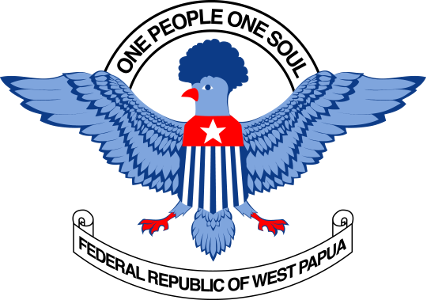A WELSH ARTIST, BRONWEN BENDER, has entered four spectacular wire-portraits of West Papuan political prisoners in the Sampari Art Exhibition for West Papua, which opens in the Australian Catholic University Gallery in Fitzroy (Melbourne) on 4 December 2015.
Bender illuminates her whitened copper-wire constructs, creating from a mass of coiled and twisted metal, a shadow-dimension that is softer or sharper, sadder or happier, bigger or smaller than its progenitor. In this three-dimensional form (light cast by a mobile phone is sufficient) her art becomes a powerful exposé of the West Papuans forced into the murky shadows of a repressive state.
Jacob Rumbiak, the influential political leader who spent years incarcerated in Indonesia, is one of Bronwen’s subjects. He believes her work, reflecting the dark spaces occupied by so many of his friends and political colleagues, is ‘magical’.
Art historian Jennifer Baulch believes Bender’s intricate thoughtfully made portraits comment on our habits of perception, and offer a deeper level of engagement with subjects whose plights are otherwise obscured.
“John Berger explained that the meaning of images is changed by what we see alongside them. But it is Bronwen’s choice of medium that so surprises and succeeds, with copper wire constituting the form and the image of her portraits, while the interplay with light allows a shadow to appear on a nearby surface. The interaction offers both a literal and metaphorical revelation, as the subject is revealed under the influence of illumination”.
According to Baulch, Bronwen’s wire portraits sit within a rich and varied world-wide tradition.
“Wire jewellery and small-scale sculptures were crafted by artisans in ancient Egypt, whose alluring work can still be seen in museums. There is also a strong history of wire art in South Africa and Slovakia, probably because of the accessibility and low cost of wire. The Slovakian tradition dates to the 17th century, when innovative wire ‘tinkers’ created cages, tableware and other functional but beautiful items. Slovakian craftsmen continue to work their tradition, although industrialisation has overwhelmed the need for functional objects. Contemporary western wire artists, like Alexander Calder, draw on themes of movement and abstraction, and like Bronwen, make full use of wire’s unique ability to both enclose and define space, while at the same time remain strikingly transparent”.
Bronwen first heard about West Papua at Exit Strategy Studios, a creative art space in Brunswick, during a screening of Dominic Brown’s Forgotten bird of paradise. “I was really moved. I’d been in Australia for two years, and couldn’t believe I hadn’t heard anything about this situation. I mean West Papua is so close to Australia”.
“My parents are glass artists in Swansea (Wales), and my mother has always been an Amnesty lady. She taught me to think about human rights and social justice. Then Dominic’s film inspired me to raise awareness of West Papua in the only way I know, which is through my art”.
In July 2015, there were still (at least) fifty-one political prisoners in West Papua, including Roy Marten Mury, and Apnel and Daniel Hegemur, who were arrested during a prayer session in Fak Fak on 3 July and charged with staging a public event without police permission (Article 510 of the Indonesian Criminal Code). The Fak Fak community was, in fact, giving thanks for the historic decision by the Melanesian Spearhead Group to grant West Papua Diplomatic Standing and Observer Status. (Between May and July, 264 West Papuans were arrested for non-violent expressions of support for West Papua’s application to join the MSG, an intergovernmental organization of four Melanesian states ~ Fiji, Papua New Guinea, Solomon Islands, Vanuatu ~ and the Kanak Socialist National Liberation Front in New Caledonia.
PHOTOS: Tommy Latupeirissa
Program of events during Sampari Art Exhibition
During the Sampari Art Exhibition for West Papua (ACU Art Gallery, 4 – 13 December), the FRWP Women’s Office is hosting a series of events to inspire a bounty of imagery and knowledge about the people and their land and their ambition to be free.
In conversation with Author Bruce Pascoe about his political thriller Ruby-eyed Coucal and the historical and cultural relations between the indigenous peoples of Australia and West Papua Saturday 5 December 2015, 2 – 4 pm
Spoken Word Poetry at Sampari Art Exhibition – featuring Jacob Rumbiak’s 2005 ‘Letter to the Heroes and Heroines’ read by Carolyn Maes, and performances by a host of other Melbourne poetic scribes Sunday 6 December 2015, 2 – 4 pm
Videos at the Honai Embassy ‘installation’ – videos from West Papua by activist Izzy Brown Friday 11 December 2015, 6:30 – 8:30 pm
Mt Carstensz (Namangkawi) Forum Abusive Visitors: panel discussion on the devastating social and environmental impacts wrought by foreign exploitation of natural resources in Mt Carstensz and the highland communities of West Papua, including rare photographs of Nemangkawi in 1971 and 1973 Saturday 12 December 2015, 2 – 4 pm
WP Rent Collective Christmas Party – featuring a Skyped interview with Edison Waromi (Prime Minister, Federal Republic of West Papua) and Bishop Hilton Deakin introducing A Dowry for the Sultan an historical novel by Colonel Lance Collins (ret.) Sunday 13 December 2015, 2 – 4 pm
ACU Gallery opening hours
Monday to Friday 11am – 7pm, Saturday to Sunday 10am – 5pm.



